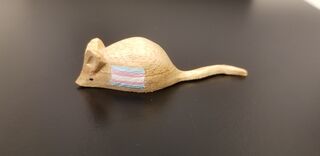Sex
Toward a Better Study of Sex Differences
Ignoring our different definitions for sex impedes science.
Posted February 16, 2022 Reviewed by Tyler Woods
Key points
- A new paper identifies sex as a non-binary and context-dependent variable.
- Accurately describing sex difference research is impossible without using inclusive language.
The oversimplification of biology often leads to harmful assumptions regarding the LGBTQIA+ community. A prime example is the field of evolutionary psychology and the study of sexuality. In a 2010 article, Drs. Charlotte Tate (She/her) and Jay Bettergarcia (They/them) explain how the field suffers under the notion that evolution is selecting for specific traits. In fact, evolution cannot select for anything, the mutations guiding the process are random, so it only selects against harmful traits as they appear. We know traits that improve reproduction are passed on but we often forget traits that do not impede reproduction may be passed on as well.
Due to this assumption, many scientists felt the expression of non-reproductive sexual behaviors appeared as a substitute to reproduction. However, the ability to express diverse sexual behaviors does not automatically prevent sex when reproduction is possible, as was likely the case for our ancestors (Pfau et al., 2021). This assumption has justified viewing the evolution of sexual orientation as a simple process guided by reproductive sex alone. In this framework, homosexual and queer identities are seen as hijacking mechanisms meant for use by heterosexuals. This is the unscientific argument used by proponents of conversion therapy.
Like evolutionary processes, oversimplifying the study of sex differences has done great harm to LGBTQIA+ individuals. A new article published in Science magazine entitled “Transgender rights rely on inclusive language” describes biological sex as a non-binary, context-dependent variable. This has led some to suggest that biological sex is being redefined and that the change is harmful to free inquiry in the sciences, namely our understanding of sex differences. The authors, Miriam Miyagi (She/they), Dr. Eartha Mae Guthman (She/her), and Dr. Simón(e) Dow-Kuang Sun (She/they), explain how this framework is not new and how it will improve sex difference research.
How are sex difference models studied in science?
Studies that examine sex differences manipulate sex-associated traits to examine their impact. This may be scaled to different organizational levels (organ vs. tissue vs. cell) and tailored to examine processes like sex development. For example, researchers can model rodent sex development at the level of spinal motor neurons; males have more neurons in the spinal nucleus controlling penile reflexes than females.
One study may find rodents with the Y chromosome always have a male number of these motor neurons. However, another study may show that rodents with the Y chromosome do not have a male number of motor neurons if their testes are removed. Y chromosome presence can guarantee high testosterone levels, but this is not the case when the tissue capable of creating testosterone is removed (Moore et al., 1996). While the presence of a Y chromosome or testis fits within societal notions of “male,” researchers studying male development may also use a female mouse with artificially elevated levels of testosterone to study sex differences as a product of the dominant hormone levels (Breedlove et al., 1982).

Why is recognizing this context-dependent quality of sex important for research?
As a sex difference researcher, one of the most frustrating aspects of reading research articles is that two papers will use the words “sex differences” but one examines the Y chromosome and the other testosterone levels. For this reason, the authors suggest, “The usage of 'male' and 'female' should be explicitly defined in any given study.” This acknowledgment of context-dependent definitions for sex will greatly improve communication within the field of sex differences, but transphobic ideologies threaten this progress.
Some transphobic activists feel that the definitions for biological sex must be limited to simple and binary variables like “large eggs vs small sperm.” If scientists accept this, meaningful research on chromosomes, hormones and all other sex-associated traits would be lost. Studying these provides valuable basic information and theoretical frameworks to sort out more complicated processes, including those in humans. Simple variables, like those desired by transphobic activists, are inadequate to describe human sex development. To make progress, scientists must follow where scientific findings lead them, not where society expects them to go.
It is also important to acknowledge how a model is limited, both in terms of research potential and applicability to humans. Unlike rodents, our complex development and important measures are often non-binary. For example, the brain shows a greater variation between individuals than any perceived difference between binary sexes (Hyde et al., 2019) while intersex conditions and differences in sex development are more common than most realize (Blackless et al., 2000). So, while examining simplified versions of human sex development using rodents is useful, a binary process is not something we expect in actual humans.
How does this relate to the transgender and non-binary community?
As STEM becomes more accepting of gender diversity, affirming diverse identities becomes less a question of scientific evidence or debate and simply about listening to and believing transgender experiences. However, that does not mean science has no place in supporting transgender individuals. As the paper's title suggests, scientific language can directly impact how transgender identities are perceived, much like evolutionary processes guided our thinking on sexual orientation. The authors point to the harmful and unnecessary policy of sterilizing transgender individuals before permitting legal gender changes in the United States as a direct result of coupling sex and gender.
Transphobic claims like “99 percent of genitals are unambiguous,” only make sense if we always model sex by genitals but, in the examples above, testosterone given to female mice becomes a male condition no matter the mouse's genitals. Somehow, accurately describing sex difference research has been translated into an attack on sex difference research. As this new paper explains, you can study sex differences and support the transgender community, but only if you are willing to accept scientific facts.
References
Tate, C., & Ledbetter, J. N. (2010). Oversimplifying evolutionary psychology leads to explanatory gaps. American Psychologist, 65(9).
Pfau, D., Jordan, C. L., & Breedlove, S. M. (2021). The de-scent of sexuality: Did loss of a pheromone signaling protein permit the evolution of same-sex sexual behavior in primates?. Archives of Sexual Behavior, 50(6), 2267-2276.
Miyagi, M., Guthman, E. M., & Sun, S. E. D. K. (2021). Transgender rights rely on inclusive language. Science, 374(6575), 1568-1569.
Moore, C. L., Dou, H., & Juraska, J. M. (1996). Number, size, and regional distribution of motor neurons in the dorsolateral and retrodorsolateral nuclei as a function of sex and neonatal stimulation. Developmental psychobiology, 29(4), 303-313.
Breedlove, S. M., Jacobson, C. D., Gorski, R. A., & Arnold, A. P. (1982). Masculinization of the female rat spinal cord following a single neonatal injection of testosterone propionate but not estradiol benzoate. Brain research, 237(1), 173-181.
Hyde, J. S., Bigler, R. S., Joel, D., Tate, C. C., & van Anders, S. M. (2019). The future of sex and gender in psychology: Five challenges to the gender binary. American Psychologist, 74(2), 171.
Blackless, M., Charuvastra, A., Derryck, A., Fausto‐Sterling, A., Lauzanne, K., & Lee, E. (2000). How sexually dimorphic are we? Review and synthesis. American Journal of Human Biology: The Official Journal of the Human Biology Association, 12(2), 151-166.




